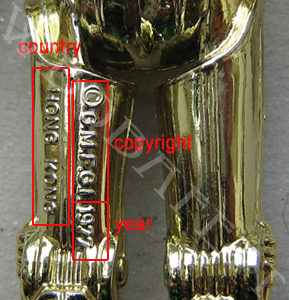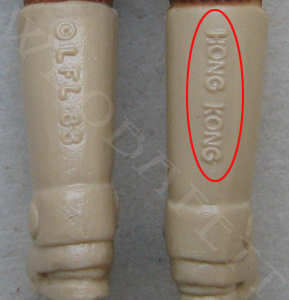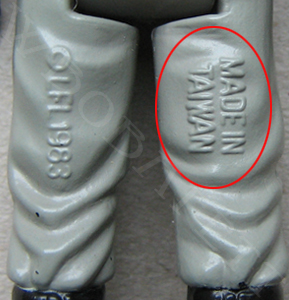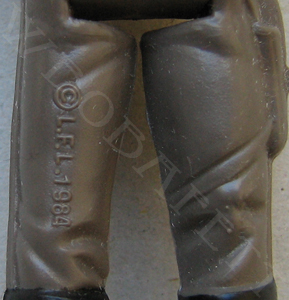Introduction to COOs

This is going to be mainly a brief introduction because of two reasons. The first reason is I that I am not a native English speaking person. The second is, if the articles are too long I am worried that less people will read. Ill try to keep it as short as possible but will give of course a deeper look inside the COO theme, because this is what this thread is mainly about. If you have further questions feel free to contact me.
THE PRODUCTION PROCESS
For the production process I advise people read the following article: 12back.com: The Creation Process
In addition, theswca.com also has good information, check out the following article: theswca.com: Steel Mold
No matter where or how you get your information its really important for this guide to know at which time in the production process the country stamps where made.
To summarize the production process we can say, First is the „original sculpt“ that is made of a metal skeleton with clay for the rough sculpture and wax for finishing the sculpt. Then comes the „hard copy“ which is a copy of the original sculpt in a very hard material which is necessary for making the steel molds. The so called „steel molds“ can be made from aluminium, steel or even brass. The „hardcopy“ is transferred into the mold with kind of a three-dimensional pantograph. This is of course just a short summary and there is many different ways, depending on the sculpture and many other aspects.
The following is now important for understanding when a coo is placed. The first figures produced in that mold is the so called „first shot“. These normally don’t have any markings! The awarding authority (Kenner) has a look at this „first shot“ and gives its okay for the production. At this point the molds first gets duplicated and then stamped and marked! I have no proof of the following but to me it makes totally sense: The steel-molds were the original ones, the ones the first shots were made from. These were duplicated in steel, aluminium or brass. Aluminium and brass are more easy to work with because they are much „softer“ then steel. Especially for the limbs (very soft plastic, less wear) no steel molds were necessary. In aluminium or also brass it would be possible to stamp the coos in with a lettering system similar to old printing systems. You have all letters made in steel which can be set together in the way you want them and get „hammered“ into the molds. Therefore you would need softer materials then steel and it would explain many nearly similar COO’s which just one letter out of line next to one where all letters are in line or another letter which is out of line.
The terms used when describing the production process can vary from author to author and can be quite confusing for many. For example the term: „Mold“. In this thread I will use the term „steel-mold“ when I am talking about the actual molds the figures were made from, even though the mold may well be made of another material. To use only the word mold would be confusing, because mold (or mould) also describes the form of a figure in the collecting world. In addition the term „mold variant“ can also describe different colored materials the parts of a figure can be made of (i.e. „Moulded legs Han Hoth“). I will use the term „mold color variant“ for better understanding when discussing these types of figures.
A) THE COPYRIGHT
The copyright starts with the typical symbol for it the „c“ with circle around it: ©. On the vintage figures it is then followed by three different abbreviations: G.M.F.G.I (General Mills Fun Group Inc.), C.P.G. (Consumer Product Group) and L.F.L. (Lucas Film Limited).
The G.M.F.G.I was used for the first 20 figures, C.P.G. only for the Boba Fett, and L.F.L. for all other figures except the R2 sensor scope (ESB) because the mold of the early R2 (solid dome) was used.
B) THE YEAR
The year is normally directly placed behind the copyright. In this case the year indicates when the copyright was acquired for the character. Its often said the figure was produced in this year, which, put simply, is wrong, because they didn’t changed the moulds every following year while producing. It also explains why the R2 with pop-up saber is marked with 1977, although he was produced not before 1985. But for sure the year indicates also the time frame beginning with the production of a character (in his original form), because that simply goes together with acquiring the copyright.
Of course also in this case there is some exceptions, i.e. The Brazilian R2 with 1985 on it or, the Barada that exists with 1984 as well as 1985. I also like to mention the R5-D4 which has 1977 marks and 1978 marks on it, because the mould from the R2 was used for the 1977 marked ones, and the COO was not altered in this case.
C) THE COUNTRY
The country marks indicate where the figure was produced. Which means where the plastic was injected into the „steel-moulds“. This doesn’t indicate where it was assembled, painted or packed, which can differ from the country mark.
From time to time the production location was changed, for several reasons like: lower costs, rising the production numbers, etc. In these cases the moulds were normally altered and the country marks where changed. In the later period of production this all got messed up and the „no COO figures“ (means no country marks) were born. I think Kenner realized that it is more simple to just stamp the locations on the card back then change the moulds every now and then.
The first production location was for sure Hong Kong. There is many controversial opinions what happens next. Taiwan coos can appear on ANH characters and ROTJ characters not on a single ESB character. There are two facts about Taiwan coos. The first is that these are not altered moulds. They belong to the „original stamped“ ones and can already appear on SW 12-back cards (i.e. Luke). And the second is they were never changed into a no COO. Regarding this we probably can say: The Taiwan „steel-moulds“ were produced for Taiwan and stayed in Taiwan, while the Hong Kong „steel-moulds“ made there way to China and Macau where some of them were altered. The way they were altered can differ heavily and I’ll try to give an overview which can never be 100% because exceptions can happen.
Figures were also produced, and by produced I mean the injection process, in Argentina (Top Toys), Brazil (Glasslite) and Mexico (Lili Ledy). In Argentina brand new molds where created for the Top Toys line, these have no COO marks at all (no copyright, no year, no country).
In Mexico and Brazil it‘s a little more complicated. Glasslite (the Licensees for Brazil) altered the COO’s (changed the year) on the C-3PO and R2 moulds but kept unaltered COO’s for the rest of the line. Lili Ledy (The Licensee for Mexico) used many moulds as they were. But they produced also some unique COO’s. I have a non proven theory and try to explain it here:
The unique coos seem not to be altered. The mould seems to be completely new with a unique „country stamp“(indeed these are all „no COO stamps“ with year and copyright or „no marks at all“ regarding the Logray).
The figures I’m talking about are: Klaatu, Squid Head, Biker Scout, Gam Guard, Nien Nunb, Chief Chirpa, Logray, Lando Skiff, Ree Yees, Vader and Yoda. (Although some of these appeared in Spain with the same COO, but IMO these were bought in Mexico and just packed in Spain).
Regarding these figures all have one thing in common: They all appeared also on MIM (Made in Mexico) cards in the USA. Given that these molds were not altered and the fact that new „steel-molds“ are very expensive it totally makes sense that exactly these figures were produced for more than just the Mexican market. And even more it is assumed that Paploo and Lumat were only produced in Mexico for the worldwide market which also appeared on MIM cards. So you can see the situation in South America is very complicated, but this is nothing when compared to what happened in Europe.
During the last period of production for Europe, coos were deleted and replaced by rough scars. The figures themselves can have pretty obvious paint variants and coo variants can be found in Spain (PBP), France (Meccano) and England (Palitoy). Wild theories always try to explain the unexplainable. The huge amount of different paint variants on figures with exactly the same COO markings can be very confusing. In addition the materials the figures are made of can be exactly the same and in some cases vary quite a bit. So we have more then one question mark here.
Its unknown and unlikely that all of the European countries produced (plastic injection) their own figures. However it has been noted that PBP (Spain) had the ability to and were probably the only company in Europe actually manufacturing toys.
More proof that PBP manufactured figures can be found with by looking at the Spanish variants that exist in really low numbers and are only known to have appeared on PBP cards. They are also made from different materials then all other figures known with the same COO like the Stormtrooper (Ledy type no COO, creamy torso), Han Hoth (pale face and more violet torso) and Biker Scout (the „marshmallow“ looking limbs and head are unique). Also some of the accessories which appeared on Spanish cards are really unique like the red harness from 4-LOM.
The numbers of these are partially so low, that even on their „origin-card“ mostly other (non spanish) produced figures can be found. We are not 100% sure that PBP manufactured all their figures or for how long but it makes a lot of sense that they did produce some. Couple the strange variants that are found only on Spanish cards with the various stickers attached to carded figures with the text „Made in Spain“ written on them, it all adds up. Besides, it would make little sense for one of the Asian manufacturers to send these variants only to Spain in such low quantities.
The point is that its pretty sure that PBP (formally known as POCH) already painted some figures themselves in the ESB area (31 and 37/41A backs). What can be found on Poch cards is mostly „Hong Kong“ and „Made in Hong Kong“ marked figures (slightly or heavily different painted and packed). It seems they bought their figures unpainted and painted and assembled them on their own.
In addition some Ledy figures can pop up on Spanish ROTJ cards like Yoda, Ben Kenobi, Luke Bespin etc. These are exactly like their originals in Mexico. Many people tried to track down the differences but IMO is there is simply non, not even in the accessories. So if we just look at the Spanish market we can say:
- likely bought unassembled and unpainted figures to paint and pack them (early ESB)
- likely produced their own figures (mold process plus paint process in later ESB and ROTJ area)
- and finally bought finished figures from Mexico (ROTJ) and Taiwan (ESB, ROTJ) to pack them.
PBP also seem to have exported their finished figures to other company’s like Meccano or Palitoy where they were packed on their domestic cards.
You can see that even trying to work out and assume what happened with one company is very hard work, the European part of the Vintage Star Wars puzzle is almost it’s own puzzle and possibly one that we can’t solve without concrete information.
Two points I like to add to show how complicated this detective work is:
Case: PBP Biker Scout
The loose collectors always knew that this must be a Spanish variant because he was mostly found there loose. But no carded example showed up over years. All carded PBP Bikers that survived seemed to be Taiwan marked Biker Scouts. Nobody had any explanations for this.
Finally last year the one and only example of a packed PBP Biker with correct figure showed up. It is the same card all over (PBP ROTJ 65-back) like the Taiwan figures appeared on.
Case: PBP Bossk
This is also a very rare variant. Just like the PBP Biker mentioned above, it can be found loose in Spain but not a single PBP carded one has been found. On the other hand this variant was found on British (Palitoy ESB 45back, single stem blister) and German (General Mills ESB 45back, single stem blister) cards whilst only one loose example was found in England (as far as I am aware). So the real origin of this figures stays an unsolved mystery. The carded examples seem to be found in completely different locations to the loose ones and completely mess with the theory.
To me it will always be a big riddle and we may never know everything about these figures. We can assume that the European companies carded a mixture unpainted figures that had to be painted on site before being packaged and pre-painted figures all ready to be packed. Maybe they had some kind of „product-sharing“ system. Every country was in charge of producing certain characters and there had to be a confusing exchange of finished and unfinished products. In the last years of production all overstock was probably thrown together and so some figure variants found their way one so many different card backs and so it will be impossible to be sure where the figures were produced/painted, when they were made and who produced what.
Maybe one day its possible to bring a little more light into all of this, but till then speculations are the only thing we have. And of course lots of beautiful and rare figure variants which make collecting loose variants so interesting.
To read more about the European Trilogo carded variants I can only advise you to read here: Trilogo.info
At the end of the day one point is very important: The country stamp is in most cases no proof of where or when a figure was sold. Lots of collectors still try to categorize the figure-markings to cards or baggies. Some of these „rules“ are: Ledy is always no COO, China figures appeared only in China baggies, Trilogo has always no COO figures on it, Scarred out figures are always PBP, Taiwan figures only appeared in Europe, etc, etc. These „rules“ are all wrong and in so many cases. There is China figures even on HK cards, no COO figures on ESB cards and many HK figures on Trilogo cards. You can have China, HK, and no COO figures on Ledy cards, etc. You can of course find more Taiwan figures in Europe and some Hong Kong COOs seem to only have appeared in the US, but this is all very unsure and can never be for 100%.
So what is the COO good for then? In fact its more a stamp that marks a certain mold. Molds can be duplicated or „travel“ from producer to producer. Exceptions can be found in nearly all cases. Overstock was shipped in other countries and packed there on other cards, etc. So this thread is a reference which shows the stamps in relation to their mold and paint variants. To determine where or when these figures appeared is in most cases nearly impossible.









